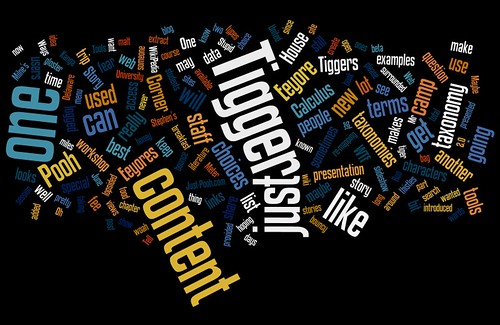
Wordle Does Feeds by cogdogblog
posted 28 Jul ’08, 10.57am MDT PST on flickr
The uber nifty Wordle tag cloud generator now can take any URL that has an RSS feed and generate one of those lovely word maps of content.
Here is what the latest blabber from CogDogBlog has in it- heavily weighted by my serious examination of the Pooh- Eeyore Debate.
What would be cool is to grab a time series of these to see how word use changes over time.
And now if I ran a new Wordle, my Wordle would contain “Wordle” since I am blogging about it.
Oi, the recusrion!


Alan,
I’m looking for an RSS Feed where it can support images like what you did with the normal RSS Feed generator at RSS2J. Is that possible as I’ve seen so many websites having their recent posts with images.
I don’t know how to reach you and this is the best platform available.
Actually, I think the interesting recursion is how you mention the Pooh-Eeyore debate (although, I thought it was Tigger?) after seeing it prominently featured in the cloud. So now, it may be even moreprominently featured. A naive blogger who kept doing new clouds might keep this positive feedback loop going for a while, each new post commenting on how that crazy business about Eeyore and Tigger keeps just getting bigger 🙂
OK, geeky amusement now out of my system. Anyway, I wanted to mention that I’ve had similar ideas about tracking the changes in word use in feeds over time, and the presenting them in a tag cloud. In my spare time, I’ve been working on a PHP script to do just that. I’ll give you a shout and link to the source code when I finish it.
Actually Jason the blog post came first. Since I have full feeds, those prominent wordle words are heavily weighted from the first post. But yes, I could devolve into CogDogTiggerEeyoreBlog.
Your idea is very cool and I am absolutely interested. I really dig when someone codes my ideas 😉
Well, it’s four months later, but I did finally get around to finishing that time-aware tagcloud. As you compare one time frame with another, it animates the words to show how their frequencies change. You can also compare different authors. Clicking a word gives you access to all the posts that used it.
Right now, it uses the feeds from Scott McLeod’s list of the top 50 edublogs as ranked by Technorati, so you’re in there 🙂
ah yes: the address. http://jasonpriem.com/feedvis
Wow.
Jason, that is freaking amazing. I’m still taking it in and poking around, but this is very exciting, and not only provides visualization, but the data on frequency is astounding. And thanks for sharing the code! Gonna be tinkering with some feed collections.
Cool! I’m glad you like it. It’s kind of rough around the edges yet, so let me know if you run into any trouble.